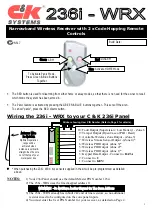
ATR833A / P/N 833A-(xxx)-(1xx)
Operation and Installation
16
Dokument-Nr.: 01.1411.010.71e / Revision: 3.00
2.5 Frequency Setting
Frequency setting is always done by the two steps of
1. entering a new standby frequency to the desired value, and then
2. interchanging the new standby frequency and the previous active
frequency by using
.
Entering a new standby frequency can be done by
a) manual input
,
b) recall of previously stored frequencies from the user memory, or
c) recall from the list of the last 10 used frequencies.
2.5.1 8.33 / 25 kHz Channel Width Selection
Whether a frequency is used with channel width 8.33 kHz or 25 kHz, is
automatically determined by the value of the frequency entered, and
requires no additional user activity.
Channels used with 25 kHz width are entered in multiples of 25kHz:
123.500, 123.525, 123.550, 123.575, 123.600 etc. These are compatible
with the old 25kHz-only radios. To use the same frequencies with
8.33kHz width, the frequency values entered are increased by 5kHz:
123.505, 123.530, 123.555, 123.580, 123.605 etc.
This numbering scheme used for this distinction is internationally
standardised by ICAO, and consistently used in official documents (like
e.g. the VFR navigation charts) and phraseology used by ATC.
For more detailed information please refer to chapter 5 – but as said
above, for correct channel width selection this knowledge is not required.
2.5.2 Manual Frequency Input
The standby frequency is input by
•
selecting with the
button which part of the frequency to
change, and
•
changing the selected part with the
rotary
knob.
The selected part of the frequency is marked with the underline.
interchanges the newly set standby frequency and the former active
frequency.
















































